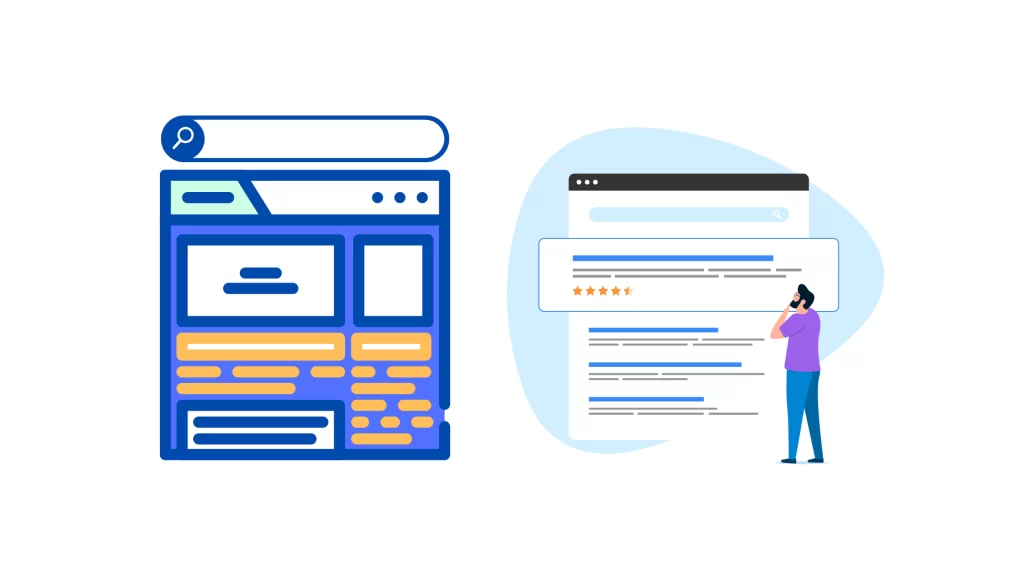Table of Contents
ToggleSERP or, Search Engine Result Page is the page that is shown to a user after they enter a query in the search bar. It has relevant websites where the user finds what they’re looking for including snippets, ads, local results, and organic search results.
Understanding SERPS and the elements it has is important for users and Website owners to make their search effective and rank higher respectively. They used to be simple in the early days – the keywords decided who was coming first.
Fast forward to today, complex algorithms are working to give users the best experience. According to Backlinko, Google uses at least 200 factors in the algorithm to rank websites. ne can find texts, images, videos, and many more interactive elements now on these pages.
In this blog, we’ll cover various components of SERPs which include organic search results, paid search results, SERP features, and how search engines rank websites. So, without taking a second more, let’s move to the next part!
Understanding SERP Components
SERP or, Search Engine Result Pages aren’t just a list of websites – they’re a whole pack of various key elements – Organic Search Results, Paid Search Results, and other SERP features. Each of them contains smaller key elements that a user can find on the SERP.
Just like a puzzle has different parts with different positions and values, when they complete the puzzle together, these features are the same. When united, they give an advanced result for the user query.
Organic Search Results
Have you ever grown a plant with no chemicals – just organic fertilizers and manure? We’re sure it would have taken a lot of effort to keep them healthy and green. The same goes for organic results. They’re the results that come up without any smart tactic or black hat ways.
Here, your website acts as a plant – when you put effort into it regularly by following the best practices without any tricks to keep your website healthy and pretty, they bloom and appear in search results on their own, without spending a penny on ads or promotions.
The thing that makes your website rank higher and show in the SERP are the words or, the keywords you use in the content of your website, the links from other websites, also called backlinks, and the speed of loading of the page. Even 49% of marketers have said that organic search results are what give the best ROI.
Now that we’ve seen what organic results are, let’s see what all we get in Organic Search Results-
Rich Snippets
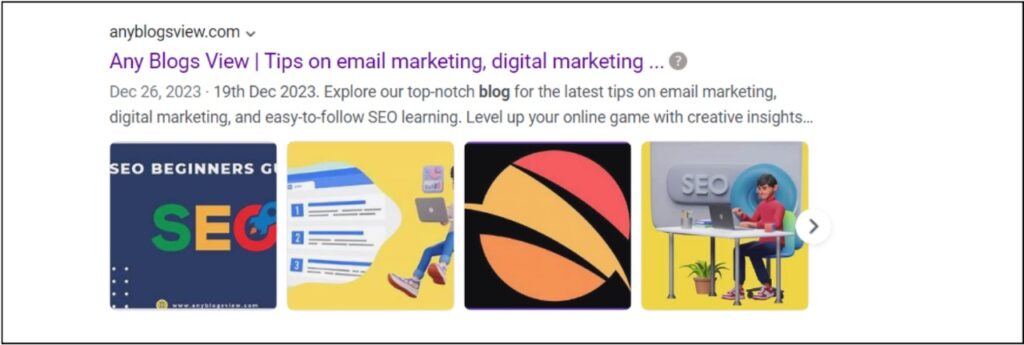
Rich snippets aren’t a ranking factor, but, they provide additional information about a website or a business. They are normally extracted from the Schema Markup of a website and tell more about the website than just a blue link and description of the website.
The rich snippets normally include ratings, reviews, the price of a product, event details, and relevant information like images, carousels, and non-text elements.
Featured Snippets
Featured snippets are when Google itself gives you the answer to your query on the top. They’re usually short paragraphs and summaries which can be in a bullet or numbered list format.
When information from your website appears as a featured snippet, it boosts your website’s visibility, traffic, and click-through rates.
Local Search Results
If a user searches for a business, shop, or a place that’s nearby, local searches show up. It includes the location, map, and more details about the place including website, directions, and timings. According to Search Engine Roundtable, 46% of Google searches are for local businesses or local services.
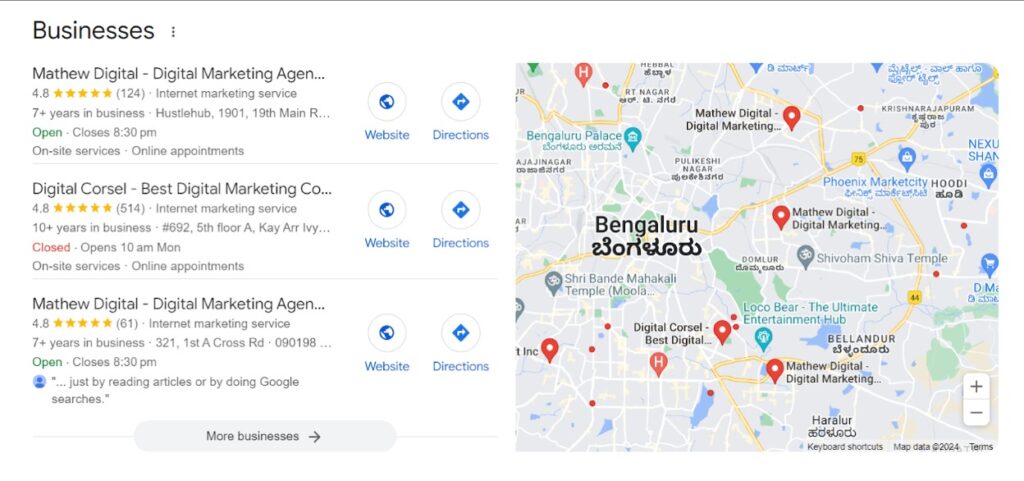
It may look like the image above. In most cases, these results consist of reviews, ratings, and the address. One can find contact details or appointment booking links as well.
Image Search Results
Wait! This was all about the text results – how about the image search results? Here, when a user enters a search query and goes to the image section, they find relevant images available on the internet.

How does this happen – the images in return for a query? When website owners, or content managers, who upload images on their website add an alt text, caption, and file name that includes the keywords – those images appear when that keyword is searched by a user.
Video Search Results
Just like image search results, Google has a section for video search results as well. These videos include keywords in themselves, their description, captions, and file names. Videos on posts earn more backlinks and give a 157% boost in search traffic, as said by Search Engine People.
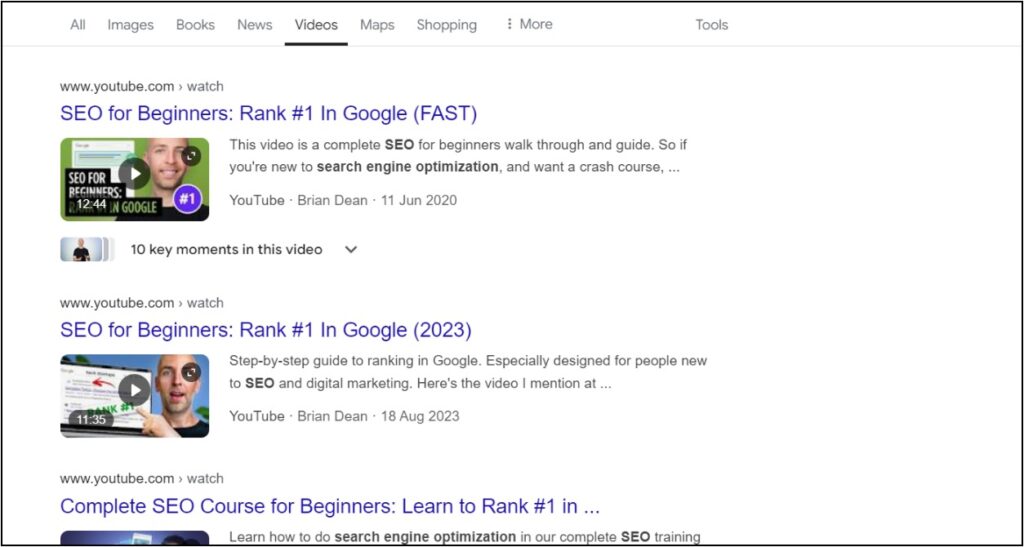
This helps the user find relevant videos to get more information on a topic they’re searching for. These videos are taken from different platforms such as YouTube, various websites, and even social media platforms.
News Search Results
This is yet another section of Google organic search results. Here, users can find the latest news updates in the areas of their interest.

The search results aren’t limited to just these sections but have many others- shopping, books, maps, etc. After knowing all this we are sure of one thing; no one’s going to go back empty-handed after searching on Google.
Paid Search Results
As the name suggests, Paid Search Results are the results that website owners paid for, to get displayed at the top. They usually show up at the top or the side of the search results. They have a label of “Ad” or “Sponsored” marked on them to let users know they’re ads and not the organic results.
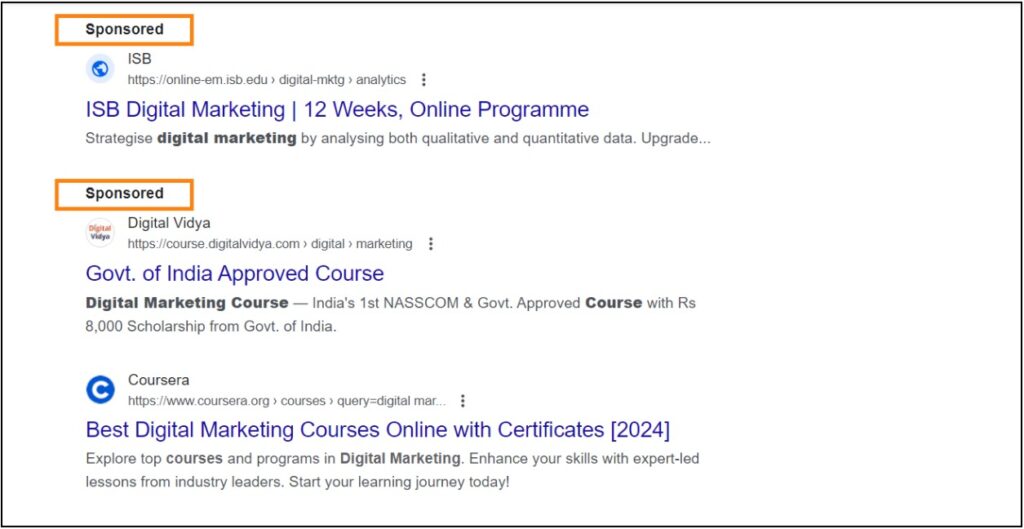
The paid ads structure has a headline, a description, and a link to the website of the person who advertised their website. Advertisers add more information like prices, features, benefits, and even phone numbers, addresses, etc to make these ads enticing.
The bids of the advertiser and the quality of the ad on the website are what they get judged for and get a rank on the search engine result pages.
SERP Features
SERP isn’t limited to just organic and paid search results, it has many other features – small but effective and informational. Here are the other SERP features –
- Knowledge Box: This box is displayed at the top and provides information about a specific, person, or things like dates, events forms, etc.
- PPA (People Also Ask): This section has relevant questions people usually ask. This helps in exploring a certain topic from more angles and points of view to get more information about it.
- PAS (People Also Search): This section is usually at the end of SERP. Here, you may find questions, related terms, or just common search terms that are relevant to your search.
SERP consists of many elements. These elements are the ones we notice, there might be many more we see but never notice. When a person understands SERP, they can search and learn more effectively.
How Search Engines Rank Pages
How do search engines rank pages? Is there a person behind the screen collecting the information and ranking them? No! Google has complex algorithms through which, the ranks are decided for the web pages for a query. While these algorithms are kept secret, we do get a glimpse of it.
There are some rules that the bots follow and sort all the pages present. The algorithms help in providing the user with the most relevant and helpful results.
On-Page SEO Factors
On-page SEO is the SEO we implement on the website – the content, keywords, media- everything. While algorithms have some fixed rules, some things that we can control to boost our rankings are –
- Keyword Optimisation: Using relevant keywords in the content and on the website naturally to help search engines find the webpage and understand what it is about.
- Relevant and Quality Content: The content’s quality and relevancy play an important role in helping a website rank higher on SERPs.
- User Experience: Google prioritizes user experience over any other element or practice. To make your website user-friendly and rank it, one can make sure that their website is easy to navigate through, has a high loading speed, and excels in mobile friendliness.
The listed are just three ways to make your website ready to rank, but one can advance in image optimization, add multimedia, and make their website more creative to attract user and improve their ranks on SERPs.
Off-Page SEO Factors
Off-page SEO is the actions we take outside the site to increase its authority and credibility. It includes backlinking, social engagement, and information submission on different high authority and genuine directories.
One can guest post, post on other platforms, and create effective content to gain backlinks for their website to grow its authority. Social media platforms might not be able to provide direct benefits to the website but they can increase reach, visibility, and traffic on the website indirectly.
Technical SEO Factors
Technical SEO is all about the technical side of your website- how it works, how easy it is to access and navigate, whether search engines can understand it or not, and much more. Some key elements to focus on are –
- Website speed
- Mobile-friendliness
- Easy navigation
On-page SEO, Off-Page SEO, and Technical SEO together make a website powerful and ready to rank when implemented correctly and updated regularly. High-quality content, a strong online presence, and an easy interface can boost the website’s performance and rank it higher.
Conclusion
Getting to know SERPs is important, and most importantly, beneficial for website owners and business owners. The search engine has evolved way more than one could ever think in the earlier days – and here we are, in a totally different phase, trying to rank our websites and align with complex algorithms.
One can optimize their website for visibility, authority, and more traffic eventually increasing the conversions. One should stay updated with the SERP trends to be able to come ahead and stand out from the crowd.
Ultimately, mastering the SERP and aligning with it is the only way you can bring success to your website. Implementing strategies and continuously updating and monitoring your website helps in take a step closer and gives you a competitive edge.

